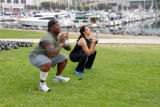Does Yoga provide more improvements in health and fitness than Pilates? Which one is easier to get started?
Practitioners claim that if you are looking for the well-being of mind, body and spirit, you should choose Yoga; if you are looking for a leaner, toned and fit body then the choice is Pilates. Both these forms of exercise are beneficial for over all health. Usually choosing between them is a matter of personal preference. In general, the focus of Pilates is on muscular strength and yoga focuses on stretching, flexibility and spirituality. Pilates involves using exercise apparatus like small weighted balls, large exercise balls, disks, or a trapeze table; all you need for Yoga is a mat.
Comparison chart
| | Pilates | Yoga |
|---|---|---|
 |  | |
| Definition | Pilates pronounced "Puh - LAH - Teez", a physical fitness system that was developed in the early 20th century by Joseph Pilates focuses on the core postural muscles that help keep the body balanced and are essential to providing support for the spine | An ancient practice from the northern India known as path to both, physical as well as mental well being which includes everything from physical posture and healthy diet to breathing, relaxation and meditation skills |
| Approach | Mind and body approach to exercise | Mind, body and spirit approach to exercise |
| Started | Around 80 years ago | 5000 years ago |
| Areas of focus | Mental concentration, breathing and movement | Kkind to all beings, including ourselves, and to search for balance in our lives and lifestyle |
| What is it? | Complicated system of effective but gentle, whole-body conditioning and corrective exercises | Yoga is a lifestyle rather than simply an exercise |
| Physical areas of focus | Concentrates on building core strength in the body and lengthening the spine | Considered therapeutic and aims at uniting the body with mind and spirit and helps people find harmony and release stress |
| How? | Pilates is about moving in ways that help strengthen your powerhouse, including your stabilizing muscles | Involves static poses, which are held while exploring your breathing, physical feelings and emotions |
| Emphasis on | Pilates emphasizes toning over flexibility (but it enhances both) | Yoga emphasizes flexibility over building strength (although it enhances both) |
| Breathing & Concentration | Pilates instructs an individual to inhale through the nose and exhale through mouth | Yoga practitioners are taught to inhale and exhale through the nose only |
| Practice | Performance is on the mats as well as the pilates machines which help build a longer, leaner and a dancer -like physique | The different styles are generally practised in a group sitting on a yoga mat with the aid of a yoga instructor |
| What to choose? | Pilates should be practised if an individual wants an exercise that improves flexibility while toning muscles - especially abs | Preferred If someone wants to concentrate more on flexibility less on toning , and also searching for something that helps reduce stress and gives an opportunity for some quiet time |
Origin
Pilates is named after its inventor Joseph Pilates, who developed the fitness system in the late 19th and early 20th century. Pilates was originally developed as a rehabilitative exercise and was practiced in a specialized studio. It has now been adapted to be practiced in community centers, gyms and physiotherapy rooms. It is also used as a mainstream class in fitness centers especially by people who want to have toned body.
Yoga in colloquial usage refers to Hatha Yoga. It originated thousands of years ago in India as part of the philosophy of yoga, which includes Raja Yoga - control of the mind, Karma Yoga - The yoga of action, Jnana Yoga - The yoga of knowledge, Bhakti Yoga - The yoga of devotion, Hatha Yoga - asanas (postures) as a form of exercise. Yoga is not a religion but the exercise regimen does encourage spirituality, meditation and a deeper understanding of oneself.
Principles and Exercises
There are 5 basic principles of Yoga. They are:
- Proper exercise - The asanas (exercises and postures) should be performed in a slow and relaxed manner.
- Proper breathing - Proper breathing techniques releases the energy (prana) to recharge the body. Emphasis is laid on the Pranayam breathing technique.
- Proper relaxation - Physical, mental and spiritual relaxation is important and is included in between asanas.
- Proper diet - Eating with awareness
- Positive thinking and meditation - Considered therapeutic and aims at uniting the body with mind and spirit and helps people find harmony and release stress.
There are 6 basic principles of Pilates. They are:
- Concentration - Exercises are done with complete concentration on the entire body.
- Control - Every movement is controlled and done consciously.
- Center - Group of muscles in the centre of the body becomes the focal point.
- Flow - The exercises are intended to flow within and into each other in order to build strength and stamina.
- Precision and breathing - Concentrate on the correct movements is expected each time the exercises are done. Deep breathing, lateral breathing, and coordinating breathing techniques are followed
Yoga focuses on stretching so beginners may find it difficult to do the poses (asanas) but as their body becomes more flexible over time, the poses become easier. Pilates may be a little easier to begin but has its own challenges of endurance and strength. Pilates may be more expensive because it requires certain equipment to complement the exercises; all you need for yoga is a mat.



 Running
Running  Karate
Karate  Fitbit
Fitbit  Elliptical
Elliptical  Freerunning
Freerunning  Deadlift
Deadlift
Comments: Pilates vs Yoga